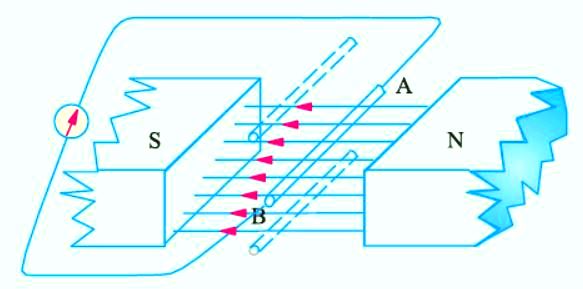Production of Induced E.M.F. and Current
In the figure given below it is shown an insulated coil whose terminals are connected to a sensitive galvanometer G. It is placed close to a stationary bar magnet initially at position AB (shown dotted). As seen, some flux from the N-pole of the magnet is linked with or threads through the coil but, as yet, there is no deflection of the galvanometer. Now, suppose that the magnet is suddenly brought closer to the coil in position CD (see figure). Then, it is found that there is a jerk or a sudden but a momentary deflection

in the galvanometer and that this lasts so long as the magnet is in motion relative to the coil, not otherwise. The deflection is reduced to zero when the magnet becomes again stationary at its new position CD. It should be noted that due to the approach of the magnet, flux linked with the coil is increased.
Next, the magnet is suddenly withdrawn away from the coil as in the figure given below. It is found that again there is a momentary deflection in the galvanometer and it persists so long as the magnet is in motion, not when it becomes stationary. It is important to note that this deflection is in a direction opposite to that of figure given above. Obviously, due to the withdrawal of the magnet, flux linked with the coil is decreased.
The deflection of the galvanometer indicates the production of e.m.f. in the coil. The only cause of the production can be the sudden approach or withdrawal of the magnet from the coil. It is found that the actual cause of this e.m.f. is the change of flux linking with the coil. This e.m.f. exists so long as the change in flux exists. Stationary flux, however strong, will never induce any e.m.f. in a stationary conductor. In fact, the same results can be obtained by keeping the bar magnet stationary and moving the coil suddenly away or towards the magnet.
AdBlock-2

The direction of this electromagnetically induced e.m.f. is as shown in the two figures given on back page. The production of this electromagnetically induced e.m.f. is further illustrated by considering a conductor AB lying within a magnetic field and connected to a galvanometer as shown in the figure given below. It is found that whenever this conductor is moved up or down, a momentary deflection is produced in the galvanometer. It means that some transient e.m.f. is induced in AB. The magnitude of this induced e.m.f. (and hence the amount of deflection in the galvanometer) depends on the quickness of the movement of AB.
From this experiment we conclude that whenever a conductor cuts or shears the magnetic flux, an e.m.f. is always induced in it. It is also found that if the conductor is moved parallel to the direction of the flux so that it does not cut it, then no e.m.f. is induced in it.

Read article – Units of Resistivity
Visit NCERTplanet.com for NCERT solutions and Textbook downloads



